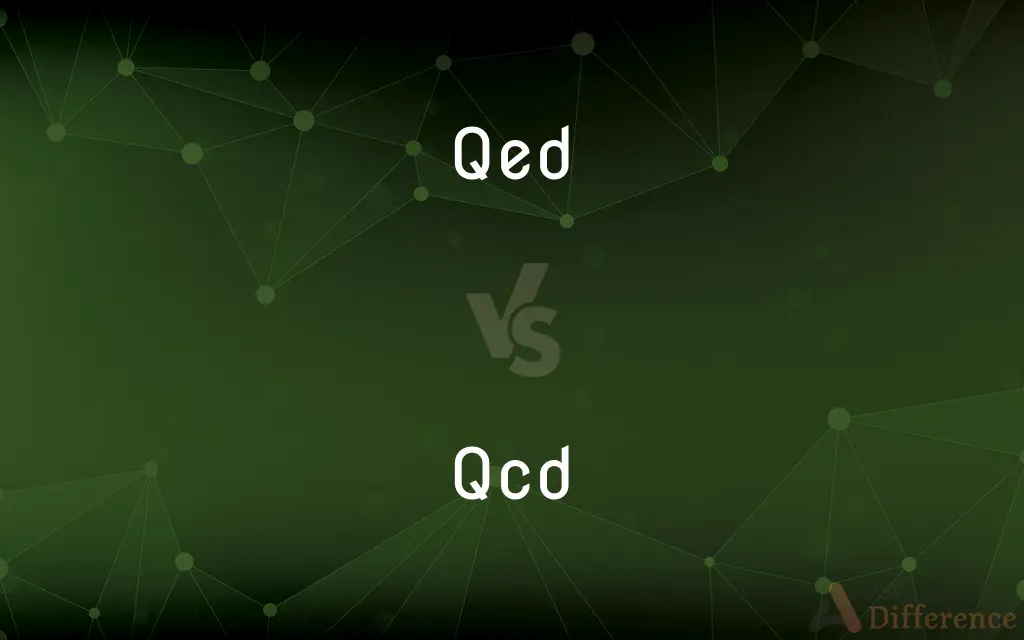QED vs. QCD — What's the Difference?
By Urooj Arif & Maham Liaqat — Updated on April 18, 2024
QED (Quantum Electrodynamics) is the quantum field theory of electromagnetism, explaining how light and matter interact, whereas QCD (Quantum Chromodynamics) is the theory of the strong interaction between quarks and gluons, components of nuclear matter.

Difference Between QED and QCD
Table of Contents
ADVERTISEMENT
Key Differences
QED, or Quantum Electrodynamics, describes the interactions between charged particles and electromagnetic fields, primarily focusing on how photons mediate these interactions. Whereas QCD, or Quantum Chromodynamics, deals with the strong force, which binds quarks together within protons, neutrons, and other particles through gluons.
In QED, the fundamental force carrier is the photon, which has no mass and is responsible for electromagnetic phenomena. On the other hand, QCD is characterized by the exchange of gluons, which themselves carry color charge and can interact with each other, unlike photons.
QED is known for its highly precise predictions regarding the electromagnetic interactions, such as the Lamb shift and the anomalous magnetic moment of the electron. Conversely, QCD is notable for explaining phenomena like confinement, where quarks are permanently bound within hadrons, and asymptotic freedom, where quarks behave as free particles at very high energies.
QED's mathematical framework is relatively simpler and has been experimentally verified to an extremely high degree of accuracy. In contrast, QCD is mathematically complex, and due to the strength of the strong force at low energies, it requires sophisticated computational techniques like lattice QCD for predictions.
Both theories are part of the Standard Model of particle physics, but they operate over different ranges and scales. QED works at the scale of atoms and photons, while QCD is crucial at the sub-nuclear level, influencing the structure and dynamics of nucleons (protons and neutrons).
ADVERTISEMENT
Comparison Chart
Fundamental Forces
Electromagnetism
Strong interaction
Force Carriers
Photons
Gluons
Charge Type
Electric charge
Color charge
Phenomena Explained
Electron scattering, light-matter interaction
Confinement, asymptotic freedom
Mathematical Complexity
Less complex, more precisely testable
More complex, requires computational methods
Compare with Definitions
Qed
Known for high precision in predictions, like the anomalous magnetic moment of the electron.
QED calculations match experimental results of electron properties with high precision.
Qcd
Uses gluons as the exchange particles that carry the force between quarks, possessing color charge.
Gluons bind quarks together in particles like protons through the strong force.
Qed
Focuses on how photons mediate electromagnetic forces between particles with electric charge.
QED describes how photons are exchanged between electrons to produce electromagnetic repulsion.
Qcd
Explains phenomena like asymptotic freedom and quark confinement.
QCD predicts that quarks behave more like free particles at extremely high energies.
Qed
A theory in physics that explains the interactions between light and matter using the principles of quantum mechanics and special relativity.
QED predicts the precise levels of energy that electrons can have in an atom.
Qcd
Requires complex computational techniques like lattice QCD to make predictions due to the strong force's nature.
Lattice QCD simulations are crucial for understanding the mass and structure of nucleons.
Qed
Applies to phenomena at the atomic and subatomic levels, especially where light and matter interact.
QED can explain the detailed spectrum of hydrogen seen in spectroscopy.
Qcd
The theory of the strong force, describing how quarks and gluons interact inside protons and neutrons.
QCD explains why quarks can never be isolated.
Qed
Forms part of the Standard Model, detailing the electromagnetic interaction part.
QED integrates seamlessly with the other quantum theories in the Standard Model.
Qcd
Also a critical part of the Standard Model, explaining the nuclear forces within an atom.
QCD complements the explanations of how atomic nuclei are held together.
Qed
Quantum electrodynamics.
Qcd
Quantum chromodynamics.
Qed
A relativistic quantum theory of the electromagnetic interactions of photons and electrons and muons
Qcd
A theory of strong interactions between elementary particles (including the interaction that binds protons and neutrons in the nucleus); it assumes that strongly interacting particles (hadrons) are made of quarks and that gluons bind the quarks together
Common Curiosities
What unique phenomena does QCD explain?
QCD uniquely explains quark confinement and asymptotic freedom, critical for understanding nuclear structure.
What is Quantum Chromodynamics (QCD)?
QCD is the theory that describes the strong interaction between quarks and gluons, fundamental in the structure of protons and neutrons.
What is Quantum Electrodynamics (QED)?
QED is the theory of how light and matter interact, emphasizing the role of photons in electromagnetic processes.
Can QED and QCD be integrated?
Both are integral parts of the Standard Model of particle physics and work together to explain different aspects of particle interactions.
How do QED and QCD impact our understanding of the universe?
They provide a deep understanding of fundamental forces and matter interactions, crucial for fields ranging from cosmology to quantum computing.
What challenges are associated with QCD calculations?
Due to the strong force's complexity and strength, QCD calculations often require sophisticated methods like lattice computations.
What advancements in QCD are currently being pursued?
Researchers are exploring the quark-gluon plasma and other high-energy states of matter to better understand QCD under extreme conditions.
How do the mathematical complexities of QCD affect its study?
The non-linear nature and strong coupling of QCD make its mathematical treatment complex, requiring advanced computational methods.
How do QED and QCD differ in their force carriers?
QED uses photons to mediate electromagnetic forces, while QCD uses gluons to carry the strong force.
Why are QED's predictions considered highly accurate?
QED provides extremely precise predictions due to its solid mathematical foundation and simpler interactions at the quantum level.
Are there experimental tests that confirm QCD's predictions?
While QCD is more challenging to test directly due to the strong force's nature, experimental evidence supports its predictions, especially at high energies.
What is the significance of the color charge in QCD?
Color charge is to QCD what electric charge is to QED; it's essential for the interactions between quarks and gluons.
What future experiments could further validate QED and QCD?
Upcoming particle collider experiments and precision measurements in atomic physics are expected to provide further insights into both QED and QCD.
How is QED relevant in everyday technology?
QED principles are fundamental in technologies involving light, such as lasers and optical fibers.
What role do gluons play in QCD?
Gluons are the mediators of the strong force in QCD, binding quarks together in hadrons like protons and neutrons.
Share Your Discovery

Previous Comparison
Pen vs. Pencil
Next Comparison
Semelparity vs. IteroparityAuthor Spotlight
Written by
Urooj ArifUrooj is a skilled content writer at Ask Difference, known for her exceptional ability to simplify complex topics into engaging and informative content. With a passion for research and a flair for clear, concise writing, she consistently delivers articles that resonate with our diverse audience.
Co-written by
Maham Liaqat












































